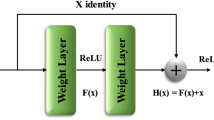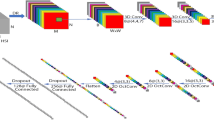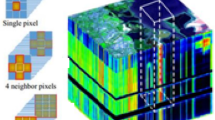Abstract
Classification in hyperspectral remote sensing images (HRSIs) is a challenging process in image analysis and one of the most popular topics. In recent years, many methods have been proposed to solve the HRSIs classification problem. Compared to traditional machine learning methods, deep learning, especially convolutional neural networks (CNNs), is commonly used in the classification of HRSIs. Deep learning-based methods based on CNNs show remarkable performance in HRSIs classification and greatly support the development of classification technology. In this study, a method in which the Hybrid 3D/2D Complete Inception module and the Hybrid 3D/2D CNN method are used together has been proposed to solve the HRSIs classification problem. In the proposed method, multi-level feature extraction is performed by using multiple convolution layers with the Inception module. This improves the performance of the network. Conventional CNN-based methods use 2D CNN for feature extraction. However, only spatial features are extracted with 2D CNN. 3D CNN is used to extract spatial-spectral features. However, 3D CNN is computationally complex. Therefore, in the proposed method, a hybrid approach is used by first using 3D CNN and then 2D CNN. This reduces computational complexity and extracts more spatial features. In addition, PCA is used as a preprocessing step for optimum spectral band extraction in the proposed method. The proposed method has been tested using Indian pines, Salinas, University of Pavia, HyRANK-Loukia and Houston datasets, which are frequently used in studies for HRSIs classification. The overall accuracy of the proposed method in these five datasets are 99.83%, 100%, 100%, 90.47% and 98.93%, respectively. These results reveal that the proposed method provides higher classification performance compared to state-of-the-art methods.
















Similar content being viewed by others
References
Chen C, Jiang F, Yang C et al (2018) Hyperspectral classification based on spectral–spatial convolutional neural networks. Eng Appl Artif Intell 68:165–171. https://doi.org/10.1016/j.engappai.2017.10.015
Roy SK, Chatterjee S, Bhattacharyya S et al (2020) Lightweight spectral-spatial squeeze-and- excitation residual bag-of-features learning for hyperspectral classification. IEEE Trans Geosci Remote Sens 58:5277–5290. https://doi.org/10.1109/TGRS.2019.2961681
Fırat H, Hanbay D (2021) 4CF-Net: Hiperspektral uzaktan algılama görüntülerinin spektral uzamsal sınıflandırılması için yeni 3B evrişimli sinir ağı. Gazi Üniversitesi Mühendislik-Mimarlık Fakültesi Derg 1:439–453. https://doi.org/10.17341/gazimmfd.901291
Firat H, Hanbay D (2021) 3B ESA Tabanlı ResNet50 Kullanılarak Hiperspektral Görüntülerin Sınıflandırılması Classification of Hyperspectral Images Using 3D CNN Based ResNet50. In: 2021 29th Signal Process Commun Appl Conf 6–9. https://doi.org/10.1109/SIU53274.2021.9477899
Ahmad M, Mazzara M, Distefano S (2021) Regularized cnn feature hierarchy for hyperspectral image classification. Remote Sens 13:1–11. https://doi.org/10.3390/rs13122275
Firat H, Uçan M, Hanbay D (2021) Classification of hyperspectral remote sensing ımages using hybrid 3D-2D CNN architecture. J Comput Sci IDAP-2021:132–140
Firat H, Uçan M, Hanbay D (2021) Hyperspectral ımage classification using MiniVGGNet. J Comput Sci IDAP-2021:295–303
Ibarrola-Ulzurrun E, Drumetz L, Marcello J et al (2019) Hyperspectral classification through unmixing abundance maps addressing spectral variability. IEEE Trans Geosci Remote Sens 57:4775–4788. https://doi.org/10.1109/TGRS.2019.2892903
Mohan A, Meenakshi Sundaram V (2020) V3O2: hybrid deep learning model for hyperspectral image classification using vanilla-3D and octave-2D convolution. J Real-Time Image Process. https://doi.org/10.1007/s11554-020-00966-z
Gowtham B, Kumar IA, Reddy TS et al (2021) Hyperspectral image analysis using principal component analysis and siamese network. Turkish J Comput Math Educ 12:1191–1198
Ahmad M, Khan A, Khan AM et al (2019) Spatial prior fuzziness pool-based interactive classification of hyperspectral images. Remote Sens 11:1–19. https://doi.org/10.3390/rs11091136
Li J, Bioucas-Dias JM, Plaza A (2010) Semisupervised hyperspectral image segmentation using multinomial logistic regression with active learning. IEEE Trans Geosci Remote Sens 48:4085–4098. https://doi.org/10.1109/TGRS.2010.2060550
Wang Y, Yu W, Fang Z (2020) Multiple Kernel-based SVM classification of hyperspectral images by combining spectral, spatial, and semantic information. Remote Sens. https://doi.org/10.3390/RS12010120
Ham JS, Chen Y, Crawford MM, Ghosh J (2005) Investigation of the random forest framework for classification of hyperspectral data. IEEE Trans Geosci Remote Sens 43:492–501. https://doi.org/10.1109/TGRS.2004.842481
Li Y, Zhang H, Shen Q (2017) Spectral-spatial classification of hyperspectral imagery with 3D convolutional neural network. Remote Sens. https://doi.org/10.3390/rs9010067
Fang L, Li S, Duan W et al (2015) Classification of hyperspectral images by exploiting spectral-spatial information of superpixel via multiple kernels. IEEE Trans Geosci Remote Sens 53:6663–6674. https://doi.org/10.1109/TGRS.2015.2445767
Fang L, Li S, Kang X, Benediktsson JA (2014) Spectral-spatial hyperspectral image classification via multiscale adaptive sparse representation. IEEE Trans Geosci Remote Sens 52:7738–7749. https://doi.org/10.1109/TGRS.2014.2318058
Camps-Valls G, Bruzzone L (2005) Kernel-based methods for hyperspectral image classification. IEEE Trans Geosci Remote Sens 43:1351–1362. https://doi.org/10.1109/TGRS.2005.846154
Palmason JA, Benediktsson JA, Sveinsson JR (2005) Classification of hyperspectral data from urban areas based on extended morphological profiles. IEEE Trans Geosci Remote Sens 43:480–491. https://doi.org/10.1109/TGRS.2004.842478
Mohan A, Venkatesan M (2020) HybridCNN based hyperspectral image classification using multiscale spatiospectral features. Infrared Phys Technol. https://doi.org/10.1016/j.infrared.2020.103326
Özdemir MF, Hanbay D (2021) Comparison of optimization algorithms for multi-object tracking FairMOT algorithm. J Comput Sci IDAP-2021:147–153
Sel İ, Hanbay D (2021) Creating a parallel corpora for Turkish-English academic translations. J Comput Sci IDAP-2021:335–340
Uzen H, Turkoglu M, Hanbay D (2021) Texture defect classification with multiple pooling and filter ensemble based on deep neural network. Expert Syst Appl 175:114838. https://doi.org/10.1016/j.eswa.2021.114838
Üzen H, Fırat H, Karcİ A, Hanbay D (2019) Automatic thresholding method developed with entropy for fabric defect detection. In: 2019 ınternational artificial ıntelligence and data processing symposium (IDAP), pp 14–17
Zhao C, Wan X, Zhao G et al (2017) Spectral-spatial classification of hyperspectral imagery based on stacked sparse autoencoder and random forest. Eur J Remote Sens 50:47–63. https://doi.org/10.1080/22797254.2017.1274566
Data H, Chen Y, Lin Z et al (2014) Deep learning-based classification of hyperspectral data. IEEE J Sel Top Appl Earth Obs Remote Sens 7:2094–2107. https://doi.org/10.1109/JSTARS.2014.2329330
Mughees A, Tao L (2017) Efficient deep auto-encoder learning for the classification of hyperspectral images. Proc - 2016 Int Conf Virtual Real Vis ICVRV 2016, pp 44–51. https://doi.org/10.1109/ICVRV.2016.16
Zhong P, Gong Z, Li S, Schonlieb CB (2017) Learning to diversify deep belief networks for hyperspectral image classification. IEEE Trans Geosci Remote Sens 55:3516–3530. https://doi.org/10.1109/TGRS.2017.2675902
Chen Y, Zhao X, Jia X (2015) Spectral-spatial classification of hyperspectral data based on deep belief network. IEEE J Sel Top Appl Earth Obs Remote Sens 8:2381–2392. https://doi.org/10.1109/JSTARS.2015.2388577
Li J, Xi B, Li Y et al (2018) Hyperspectral classification based on texture feature enhancement and deep belief networks. Remote Sens. https://doi.org/10.3390/rs10030396
Zhang C, Sargent I, Pan X et al (2019) Joint deep learning for land cover and land use classification. Remote Sens Environ 221:173–187. https://doi.org/10.1016/j.rse.2018.11.014
Iyer P, A S, Lal S, (2021) Deep learning ensemble method for classification of satellite hyperspectral images. Remote Sens Appl Soc Environ 23:100580. https://doi.org/10.1016/j.rsase.2021.100580
Roy SK, Krishna G, Dubey SR, Chaudhuri BB (2019) HybridSN: exploring 3D-2D CNN feature hierarchy for hyperspectral ımage classification. arXiv 17:277–281
Ahmad M, Khan AM, Mazzara M et al (2020) A fast and compact 3-D CNN for hyperspectral image classification. IEEE Geosci Remote Sens Lett. https://doi.org/10.1109/LGRS.2020.3043710
Ge Z, Cao G, Li X, Fu P (2020) Hyperspectral image classification method based on 2D–3D CNN and multibranch feature fusion. IEEE J Sel Top Appl Earth Obs Remote Sens 13:5776–5788. https://doi.org/10.1109/JSTARS.2020.3024841
He M, Bo Li HC (2017) Multi-scale 3D deep convolutional neural network for hyperspectral image classification. IEEE Int Conf Image Process 2017:3904–3908
Venugopal N (2020) Automatic semantic segmentation with DeepLab dilated learning network for change detection in remote sensing images. Neural Process Lett 51:2355–2377. https://doi.org/10.1007/s11063-019-10174-x
Mu C, Guo Z, Liu Y (2020) A multi-scale and multi-level spectral-spatial feature fusion network for hyperspectral image classification. Remote Sens. https://doi.org/10.3390/RS12010125
Zhong Z, Li J, Luo Z, Chapman M (2018) Spectral-spatial residual network for hyperspectral image classification: a 3-D deep learning framework. IEEE Trans Geosci Remote Sens 56:847–858. https://doi.org/10.1109/TGRS.2017.2755542
Roy SK, Dubey SR, Chatterjee S, Chaudhuri BB (2020) FuSENet: fused squeeze-and-excitation network for spectral-spatial hyperspectral image classification. IET Image Process 14:1653–1661. https://doi.org/10.1049/iet-ipr.2019.1462
Roy SK, Manna S, Song T, Bruzzone L (2020) Attention-based adaptive spectral-spatial kernel resnet for hyperspectral image classification. IEEE Trans Geosci Remote Sens 59:7831–7843. https://doi.org/10.1109/TGRS.2020.3043267
Meng Z, Li L, Tang X et al (2019) Multipath residual network for spectral-spatial hyperspectral image classification. Remote Sens 11:1–19. https://doi.org/10.3390/rs11161896
Song W, Li S, Fang L (2018) Hyperspectral image classification with deep feature fusion network. IEEE Trans Geosci Remote Sens 99:3173–3184. https://doi.org/10.1109/IGARSS.2019.8898520
Liu Y, Gao L, Xiao C et al (2020) Hyperspectral image classification based on a shuffled group convolutional neural network with transfer learning. Remote Sens 12:1–18. https://doi.org/10.3390/rs12111780
Roy S, Mondal R, Paoletti ME et al (2021) Morphological convolutional neural networks for hyperspectral image classification. IEEE J Sel Top Appl Earth Obs Remote Sens 14:8689–8702. https://doi.org/10.1109/JSTARS.2021.3088228
Ghosh P, Roy SK, Koirala B et al (2022) Deep hyperspectral unmixing using transformer network. https://doi.org/10.48550/arXiv.2203.17076
Roy SK, Deria A, Hong D et al (2022) Multimodal fusion transformer for remote sensing ımage classification. https://doi.org/10.48550/arXiv.2203.16952
Ghaderizadeh S, Abbasi-Moghadam D, Sharifi A et al (2021) Hyperspectral image classification using a hybrid 3D–2D convolutional neural networks. IEEE J Sel Top Appl Earth Obs Remote Sens 14:7570–7588. https://doi.org/10.1109/JSTARS.2021.3099118
Gao H, Yang Y, Li C et al (2021) Multiscale residual network with mixed depthwise convolution for hyperspectral image classification. IEEE Trans Geosci Remote Sens 59:3396–3408. https://doi.org/10.1109/TGRS.2020.3008286
Ahmad M, Shabbir S, Raza RA et al (2021) Hyperspectral ımage classification: artifacts of dimension reduction on hybrid CNN. Optik Int J Light Electron Opt 246:167757. https://doi.org/10.1016/j.ijleo.2021.167757
Jiang L, Zhu B, Tao Y (2010) Hyperspectral image classification methods. Hyperspectral Imaging Food Qual Anal Control. https://doi.org/10.1016/B978-0-12-374753-2.10003-6
Firat H, Asker ME, Hanbay D (2022) Classification of hyperspectral remote sensing images using different dimension reduction methods with 3D/2D CNN. Remote Sens Appl Soc Environ. https://doi.org/10.1016/j.rsase.2022.100694
Patel M, Parmar M, Doshi S, et al (2019) Novel ınception-GAN for whispered-to-normal speech conversion. In: 10th ISCA Work Speech Synth (SSW 10), pp 87–92. https://doi.org/10.21437/ssw.2019-16
Makantasis K, Karantzalos K, Doulamis A, Doulamis N (2015) Deep supervised learning for hyperspectral data classification through convolutional neural networks. In: Int Geosci Remote Sens Symp 2015-Novem:4959–4962. https://doi.org/10.1109/IGARSS.2015.7326945
Ben Hamida A, Benoit A, Lambert P, Ben Amar C (2018) 3-D deep learning approach for remote sensing image classification. IEEE Trans Geosci Remote Sens 56:4420–4434. https://doi.org/10.1109/TGRS.2018.2818945
2013 ieee grss data fusion contest. http://www.grss-ieee.org/community/technical-committees/data-fusion/2013-ieee-grss-data-fusion-contest.
Author information
Authors and Affiliations
Corresponding author
Additional information
Publisher's Note
Springer Nature remains neutral with regard to jurisdictional claims in published maps and institutional affiliations.
Rights and permissions
About this article
Cite this article
Fırat, H., Asker, M.E., Bayındır, M.İ. et al. Hybrid 3D/2D Complete Inception Module and Convolutional Neural Network for Hyperspectral Remote Sensing Image Classification. Neural Process Lett 55, 1087–1130 (2023). https://doi.org/10.1007/s11063-022-10929-z
Accepted:
Published:
Issue Date:
DOI: https://doi.org/10.1007/s11063-022-10929-z




